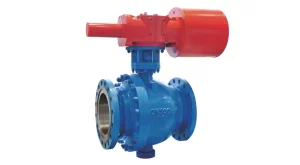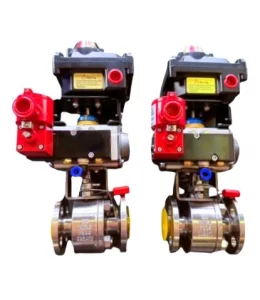Unveiling Different Types of Pneumatic Ball Valves for Industrial Use
Key Features and Benefits of Pneumatic Ball Valves
Efficient Flow Control
The efficient flow control of pneumatic ball valves is closely associated with their effective design and functionality. One of the most notable features of these valves is quarter-turn operation. It means that the time between full opening and closing is minimal, and pneumatic ball valves are particularly beneficial for services in which rapid actuation is required. As the author notes, there is another important aspect to be considered. During the operation of these valves, pressure loss is minimal due to the design, which guarantees that flow rates will be unaffected or will be impeded to a minimum extent.
Enhanced Durability
Moreover, the benefit of pneumatic ball valves is their increased lifespan. Correspondingly, the relatively robust materials used during manufacturing determine that such constructions could endure harsh impacts of the operational environment. At the same time, the independent packing gland, which is a prevalent element in the structure, allows for easy adjustment without disassembly. Such benefits promise that the construction is efficiently working in the long run, reducing the expenses related to maintenance. Miwival’s pneumatic ball valves provide reliable performance and longevity.
Cost-Effectiveness
Besides being supremely adaptable, pneumatic ball valves also bring a range of other benefits compared to other types of valves. For instance, their long service life makes them very convenient in terms of industrial applications where multiple replacements could be expensive. This results from the fact that the pneumatic actuators of the valves are designed in a self-adjusting fashion and their construction materials are incredibly strong. Another benefit is the fact that the overall cost is lower, primarily because the amount of manual adjustments is minimized, and replacements and maintenance are infrequent due to the type of materials used.
Delineating Various Types of Pneumatic Ball Valves
Floating Ball Valves
To start with, let us discuss the design of the valve. Well, for a floating ball valve, it is the ball that is actually retained in place by the valve body. The pressure coming from the opening of the valve moves the fluid against the downstream seat which helps the ball rest against the seat, ensuring a seal and the effective control of the flow. This type of ball valve is characterized by having low torques and pressures required for operation. One of such types is MIWIVAL floating ball valve with its one-piece body and lack of a leak. It also has changeable packing which does not influence the valve since there is no need to remove anything and the glands are independent and can be changed as per request. The floating power of the media during the process of closing provides for the bubble-tight shut off making this operational maintenance of the valve is low.
Trunnion Mounted Ball Valves
Unlike with floating ball valve design, trunnion mounted balls are supported from both the top and the bottom. Consequently, they are more stable during an operation and, thus, largely reduce the operating torque. Such a design makes the type particularly suitable for high pressure and large sizes. At MIWIVAL, the trunnion mounted pneumatic ball valve design has several features allowing for a bubble-tight shutoff, as well as an easily adjustable packing gland. This kind of consideration is essential for the oil and gas sector where it is common to operate in harsh conditions.
Segment Ball Valve
Segment Ball Valve is a type of control valve designed for accurate control over a wide range of flow rates, even at low levels. It features a one-piece, leak-proof body and a ball sector with top and bottom bearings, resulting in low operating torque. This allows for the use of low-torque actuators. The valve is made from high-quality materials like SMO254 and DSS 2205, ensuring durability and resistance to corrosion. With its V-shaped sector, the MC Pulp Valve provides precise control and is suitable for applications involving MC-pulp.
Factors to Consider When Selecting a Pneumatic Ball Valve
Professionals must consider several critical factors when choosing a pneumatic ball valve to achieve the best performance and longest life. The first is the wide range of applicable materials which could be stainless steel, carbon steel, plastic or brass. Other important factors would include pressure ratings and temperature tolerances.
Material Selection
The material of a pneumatic ball valve chosen is a crucial factor in determining whether such a valve is appropriate for the given environment. There are several available materials including metal, stainless steel, carbon steel, or other alloys produced for the most corrosive or abrasive conditions. For illustration, pneumatic ball valves manufactured by MIWIVAL are available in such materials as SMO254 or DSS 2205. These materials are highly resistant to such operational conditions. Thus, the chosen material has to be appropriate for the operations conditions, but as such factors as fluids with which the valve will come in contact, environmental factors among others have a substantial effect, as well.
Moreover, it’s important to consider the type of seals and certain internal components – since they highly impact the effectiveness of the sealing and friction in operation. Opting for high-quality resilient materials is recommended in this situation because they provide bi-directional sealing and rule out leakages, ensuring smooth functioning at any pressure. Appropriate materials also mean less operational wear that can be translated into extra costs and money.
Pressure Ratings
To select the appropriate pneumatic ball valve, one has to understand the pressure requirements specific to the application. As such, each valve comes assigned a certain pressure that speaks to the maximum amount that the device can handle safely. Subsequently, one has to pick the option that is rated appropriately for the operating conditions. MIWIVAL, for instance, manufactures pneumatic ball valves that are created to work reliably at Class 150 and Class 300 pressure levels, which means that they can potentially be utilized in any industrial context, including oil and gas and chemical processing.
If a valve is selected with a pressure rating lower than the required pressure capacity, it can cause catastrophic failures with leaks in the system or even damage the equipment. Therefore, it is important to know the pressure fluctuations and to select a valve that allows for maximum pressure fluctuation. Besides, considering the pressure drop during valve operation helps to increase the efficiency of the whole system.
Temperature Tolerances
Temperature tolerances are another crucial fact about pneumatic ball valves because they greatly impeach a valve’s overall performance and reliability. Such valves have to be identified to be able to operate properly within the temperature ranges the ball valve is supposed to be used in. MIWIVAL’s pneumatic ball valves are adjusted to various temperature extremes to guarantee reliable operation in environments ranging from very hot to very cold temperatures.
Evaluating the operating temperature is important since it helps in selecting the correct materials or design to withstand expansion or contraction. There will be failures in the sealing of the components if this factor is neglected. For example, certain types of elastomers might serve their purpose well in the determined rate of temperature, the properties of the devices will be altered if it is exposed to high temperatures and it may cause premature failure. So, selecting the correct valve to withstand the temperature will increase the lifetime of the parts and less disruption to the operation.
Miwival’s Range of Innovative Pneumatic Solutions
Miwival is one of the leading manufacturers and suppliers of a variety of innovative pneumatic ball valve solutions for industrial applications. The company has built a notable brand for itself by ensuring a comprehensive range of high-quality products.
Overview of Miwival’s Product Line
The product line of Miwival incorporates a plethora of designs of their pneumatic ball valves, with all of them being fabricated for particular purposes and applications. There are floating and trunnion mounted options, or the user can opt for the v-port characteristics to perform a given process. Moreover, each valve is engineered with maximum efficiency and performance, including independent packing glands allowing the user to adjust them, and a rail demonstrator, which expels or expands water to facilitate maintenance. The applications can be found in the chemicals and petrochemicals and even food-processing and pharmaceutical industries, which justifies the need for additional arrangements of the ball valves.
At Miwival, ensuring safety and performance is highly valued in their design ethic. For example, their pneumatic ball valves allow systems to work without leaks, even in high-pressure conditions, having bubble-tight shutoff capabilities.







